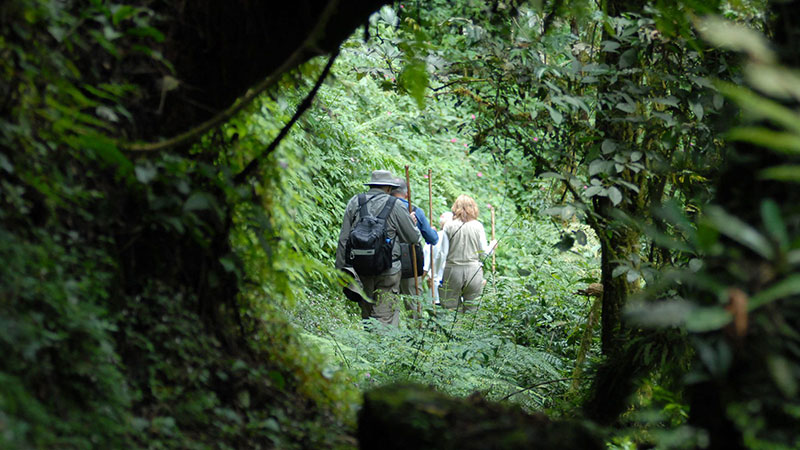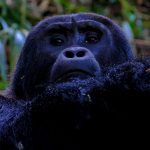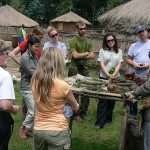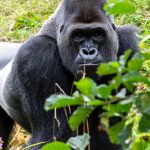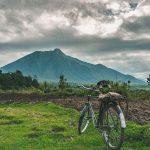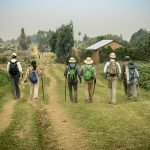The park later became the base for the American naturalist Dian Fossey to carry out her research into the gorillas. She arrived in 1967 and set up the Karisoke Research Centre between Karisimbi and Visoke. From then on, she spent most of her time in the park and is widely credited with saving the gorillas from extinction by bringing their plight to the attention of the international community. Her 1983 book, Gorillas in the Mist, combines her scientific study of the gorillas at Karisoke Research Center with her own personal story. She was murdered by unknown assailants at her home in 1985, a crime often attributed to the poachers she had spent her life fighting against.
Fossey’s life later was portrayed on the big screen in the film Gorillas in the Mist, named after her autobiography. She is buried in the park in a grave close to the research center, and amongst the gorillas which became her life. Called one of the foremost primatologists in the world, Fossey, along with Jane Goodall and Birutė Galdikas, were the so-called Trimates, a group of three prominent researchers on primates (Fossey on gorillas; Goodall on common chimpanzees; and Galdikas on orangutans). The three were sent by Leakey to study great apes in their natural environments.
During her time in Rwanda, she actively supported conservation efforts, strongly opposed poaching and tourism in wildlife habitats, and made more people acknowledge sapient gorillas. Fossey was brutally murdered in her cabin at a remote camp in Rwanda in December 1985. It has been theorized that her murder was linked to her conservation efforts. Unlike the gorillas from the Congo side of the Virungas, the Karisoke area gorillas had never been partially habituated by Schaller’s study; they knew humans only as poachers, and it took longer for Fossey to be able to study the Karisoke gorillas at a close distance.
Before her death, Dian Fossey extracted a journal in which she emphasized, “When you realize the value of all life, you dwell less on what is past and concentrate more on the preservation of future”. She started a Dian Fossey gorilla fund project, which has continued to help in the conservation of mountain gorillas and promoting gorilla tourism in volcanoes national park. History tells that the campaign by Dian Fossey against poaching generated hatred and negative attitudes by poachers who revised all means to assassinate her. Fossey strongly opposed wildlife tourism, as gorillas are very susceptible to human anthroponotic diseases like influenza for which they have no immunity. Fossey reported several cases in which gorillas died because of diseases spread by tourists.
On three occasions, Fossey wrote that she witnessed the aftermath of the capture of infant gorillas at the behest of the park conservators for zoos; since gorillas will fight to the death to protect their young, the kidnappings would often result in up to 10 adult gorillas’ deaths. Through the Digit Fund, Fossey financed patrols to destroy poachers’ traps in the Karisoke study area. In four months in 1979, the Fossey patrol consisting of four African staffers destroyed 987 poachers’ traps in the research area’s vicinity. The official Rwandan national park guards, consisting of 24 staffers, did not eradicate any poachers’ traps during the same period. In the eastern portion of the park not patrolled by Fossey, poachers virtually eradicated all the park’s elephants for ivory and killed more than a dozen gorillas. Fossey helped in the arrest of several poachers, some of whom served or are serving long prison sentences.
While gorillas from rival gang groups on the mountains that were not part of Fossey’s study had often been found poached five to ten at a time and had spurred Fossey to conduct her own anti-poaching patrols, Fossey’s study groups had not been direct victims of poaching until Fossey’s favorite gorilla Digit was killed in 1978. Later that year, the silverback of Digit’s Group 4, named for Fossey’s Uncle Bert, was shot in the heart while trying to save his son, Kweli, from being seized by poachers cooperating with the Rwandan park conservator. Kweli’s mother, Macho, was also killed in the raid, but Kweli was not captured due to Uncle Bert’s intervention; however, three-year-old Kweli died slowly and painfully of gangrene, from being brushed by a poacher’s bullet.
The Volcanoes National Park became a battlefield during the Rwandan Civil War, with the park headquarters being attacked in 1992. The research centre was abandoned, and all tourist activities (including visiting the gorillas) were stopped. They did not resume again until 1999 when the area was deemed to be safe and under control. There have been occasional infiltrations by Rwandan rebels from the Democratic Forces for the Liberation of Rwanda in subsequent years, but these are always stopped quickly by the Rwandan army and there is thought to be no threat to tourism in the park.
Visitors can pay homage to the legendary scientist and gorilla advocate Dian Fossey with a hike to her tomb or a visit to the Dian Fosse Gorilla Fund that continues her legacy of research and advocacy to this day. Hiking to the graves is not as easy as you may think, but it’s quite short lasting for roughly 1-3 hours from the starting point. The hike is not as strenuous as hiking the Virunga volcanoes but it’s quite tiresome requiring one to be physically fit and committed. To ease the movements, travelers are also reminded to wear hiking boots to overcome the muddy and slippery grounds especially in the rainy season. Similarly, dress in long trousers, which you will tack into stockings to prevent bites from ground insects and being hurt by stinging nettles.
